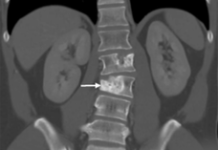On 25 May 2022, the US Food and Drug Administration (FDA) approved ivosidenib (Tibsovo, Servier Pharmaceuticals LLC) in combination with azacitidine for newly diagnosed acute myeloid leukaemia (AML) with a susceptible IDH1 mutation, as detected by an FDA-approved test in adults 75 years or older, or who have comorbidities that preclude use of intensive induction chemotherapy.
Approval was based on a randomised, multicentre, double-blind, placebo-controlled study (AG120-C-009, NCT03173248) that included 146 patients with newly-diagnosed AML with an IDH1 mutation who met at least one of the following criteria: age 75 years or older, baseline ECOG performance status of 2, severe cardiac or pulmonary disease, hepatic impairment with bilirubin > 1.5 times the upper limit of normal, creatinine clearance < 45 mL/min, or other comorbidity. Patients were randomised 1:1 to receive ivosidenib, 500 mg daily (N = 72), or matched placebo orally once daily (N = 74), on days 1-28 in combination with azacitidine 75 mg/m2/day on days 1-7 or days 1-5 and 8-9 of each 28-day cycle until disease progression, unacceptable toxicity, or haematopoietic stem cell transplantation.
Efficacy was established based on improvements in event-free survival (EFS), overall survival (OS), and rate and duration of complete remission (CR). EFS was defined as the time from randomisation until treatment failure, relapse from remission, or death from any cause, whichever occurred first. Treatment failure was defined as failure to achieve CR by 24 weeks.
EFS events occurred in 65% of patients on the ivosidenib plus azacitidine arm and 84% on the placebo plus azacitidine arm (hazard ratio [HR] 0.35; 95% confidence interval [CI] 0.17, 0.72, p = 0.0038). Median OS was 24.0 months (95% CI 11.3, 34.1) in the ivosidenib plus azacitidine arm and 7.9 months (95% CI 4.1, 11.3) in the placebo plus azacitidine arm (HR 0.44; 95% CI 0.27, 0.73; p = 0.0010). CR was 47% (95% CI 35%, 59%) in the ivosidenib plus azacitidine arm and 15% (95% CI 8%, 25%) in the placebo plus azacitidine arm. Median duration of CR was not estimable (NE) in the ivosidenib plus azacitidine arm (95% CI 13.0, NE) and 11.2 months (95% CI 3.2, NE) in the placebo plus azacitidine arm.
The most common adverse reactions of ivosidenib in combination with azacitidine or as monotherapy (≥ 25% in any study) were diarrhoea, fatigue, oedema, nausea, vomiting, decreased appetite, leukocytosis, arthralgia, dyspnoea, abdominal pain, mucositis, rash, electrocardiogram QT prolonged, differentiation syndrome, and myalgia. Prescribing information contains a Boxed Warning alerting healthcare professionals and patients about the risk of differentiation syndrome which may be life-threatening or fatal.
The recommended ivosidenib dose is 500 mg taken orally once daily with or without food until disease progression or unacceptable toxicity. Start ivosidenib administration on cycle 1 day 1 in combination with azacitidine 75 mg/m2 subcutaneously or intravenously once daily on days 1-7 (or days 1-5 and 8-9) of each 28-day cycle. For patients without disease progression or unacceptable toxicity, treatment is recommended for a minimum of 6 months to allow time for clinical response.
Full prescribing information for Tibsovo is available here.
This review used the Real-Time Oncology Review pilot programme, which streamlined data submission prior to the filing of the entire clinical application, and the Assessment Aid, a voluntary submission from the applicant to facilitate the FDA’s assessment. The FDA approved this application about 6 weeks ahead of the FDA goal date.
This application was granted priority review and breakthrough designation. Ivosidenib also received orphan drug designation for AML on 9 June 2015.
Healthcare professionals should report all serious adverse events suspected to be associated with the use of any medicine and device to FDA’s MedWatch Reporting System.
For assistance with single-patient INDs for investigational oncology products, healthcare professionals may contact FDA’s Oncology Center of Excellence Project Facilitate.







